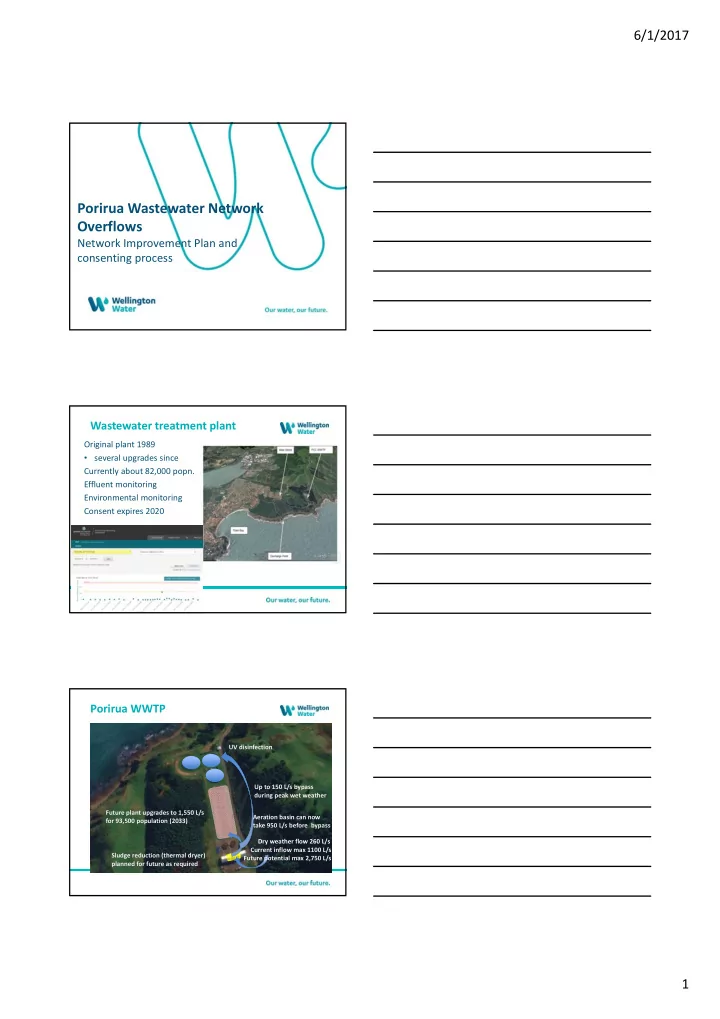

6/1/2017 Porirua Wastewater Network Overflows Network Improvement Plan and consenting process Wastewater treatment plant Original plant 1989 • several upgrades since Currently about 82,000 popn. Effluent monitoring Environmental monitoring Consent expires 2020 Porirua WWTP UV disinfection Up to 150 L/s bypass during peak wet weather Future plant upgrades to 1,550 L/s Aeration basin can now for 93,500 population (2033) take 950 L/s before bypass Dry weather flow 260 L/s Current inflow max 1100 L/s Sludge reduction (thermal dryer) Future potential max 2,750 L/s planned for future as required 1
6/1/2017 Key Issues – Network Improvement Frequent unconsented wastewater overflows • Non compliance with the Natural Resources Plan (NRP). A formal warning letter already received from GWRC • Some parts of the Trunk Network inadequate, impediment to growth • Compromised public health and safety • Entry of contaminants into waterways causing adverse environmental effects • Offensive to Maori values • Community expectations not currently met • No short term fix Wet weather and Dry weather issues Unconsented wet weather overflows ‐ CBD Overflow Chamber • Wastewater overflows from this location on average 12 times a year • Average volume per overflow 9,000m 3 discharging into Porirua inner ‐ harbour 2
6/1/2017 Unconsented Network Overflows Background Confirmed overflow locations Activities Undertaken to Understand Network Issues • Developed a high level Wastewater Master Plan • Wastewater flow monitoring • Rainfall monitoring • Overflow monitoring • Water quality monitoring • Wastewater model update • Pipe and manhole inspections • Monitoring wastewater pump station operations • Assessing inflow and infiltration severity 3
6/1/2017 Technical Options considered to date Initial cost estimate range • Increased pipe capacity (conveyance) $75M to $80M • Cross ‐ harbour pipeline $96M to $107M • Treated overflows $23M to $33M • Storage $32M to $56M Note: increased management of inflow and infiltration is part of all options Other alternatives were considered but dismissed: • Constructing a second treatment plant elsewhere • Pumping Tawa/Johnsonville wastewater flows into the Wellington City collection system for treatment at Moa Point Option 1: Conveyance to WWTP Ivey Bay Station upgrades upgrades Local upgrades in contributing catchments to convey residual overflows & reduce 20 ‐ 30% through I/I reduction Upgrade to WWTP to handle excess inflow PS34 upgrade and rising main duplication Upgrade stream Pros Cons crossings PS20 and rising Less High Cost Local upgrades in main duplication Cannons Creek Local upgrades in network OF Tawa/Glenside No visual Increased impacts flow to TP Option 2: Northern Diversion NEW cross ‐ harbour pipeline Local upgrades in contributing catchments to convey residual overflows & reduce 20 ‐ 30% through I/I reduction Ivey Bay upgrades Upgrade to PS35 and rising main Section of pipe redundant Upgrade to WWTP to handle excess inflow PS34 upgrade and Pros Cons rising main duplication Less network High Cost Upgrade stream OF crossings PS20 and rising No visual OF at TP main duplication Local upgrades in Cannons Creekside Local upgrades in impacts Tawa/Glenside Good Consenting redundancy risk 4
6/1/2017 Option 3: Peak flow treatment in ‐ catchment Pump and local upgrades Local upgrades in contributing catchments to convey Paremata residual overflows overflow & reduce 20 ‐ 30% through I/I reduction Ivey Bay upgrades Pros Cons Low Cost Consenting risk City Centre overflow Can be Public implemented objections to Pump upgrades Local upgrades in in stages treated Cannons Creekside Local upgrades in Tawa/Glenside discharges Immediate High Opex benefits cost Option 4: Storage Paremata storage Upgrade EXISTING cross ‐ harbour pipeline Local upgrades in contributing catchments to convey residual overflows & reduce 20 ‐ 30% Ivey Bay through I/I reduction upgrades Upgrade to PS35 and rising main Upgrade to WWTP to handle excess inflow Pros Cons PS34 pump upgrades Low cost Consenting Storage plus local challenges upgrades PS20 pump Local upgrades in capex staging High visual upgrades Cannons Creekside opportunity impacts Storage plus local upgrades in Tawa/Glenside Difficult to site Inflow and Infiltration programme ‐ focus in Cannons Creek Background 5
6/1/2017 Inflow and Infiltration reduction Source reduction is important • It is anticipated a 25% reduction of inflow and • infiltration could be economically achieved Currently Inflow and Infiltration programmes are • being implemented in Cannons Creek, Duck Creek and Linden sub catchments Increased management of inflow and infiltration is • part of all options listed in the previous slides Wet weather monitoring Monitoring will help understand the effects of overflows • Wet weather monitoring regime about to get underway • Monthly monitoring ongoing • Consenting Process What are we consenting? Investigation and technical option assessment • work completed to date ‐ much good work done The options now need to be considered within a • broad RMA context Wastewater discharges to fresh water are a non ‐ • complying activity under the NRP and very difficult to consent RMA option assessment process has commenced • 6
6/1/2017 Consenting Process (continued) Engagement focus Need to inform on work done to date and engage • on potential options Multi ‐ channel engagement proposed, reaching • out to all interested and affected groups, parties and stakeholders Community input essential to identifying a • ‘preferred option’ Co ‐ ordinated with engagement on the Porirua • WWTP main discharge consent renewal (expires 2019) Consenting Process (continued) Potential short term and long term outcomes? Any preferred option will be subject to PCC LTP funding • and council priorities Long term solution based on principles of adaptive • management, flexibility and long term investment Application of the Best Practicable Option approach • Discussion Short term consent to facilitate long term investment? • Is the Whaitua the planning ‘vehicle’ to deal with • overflows instead? Questions? 7
Recommend
More recommend